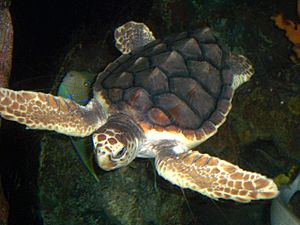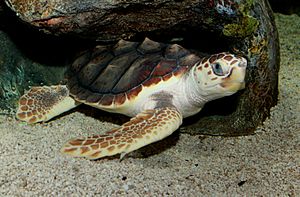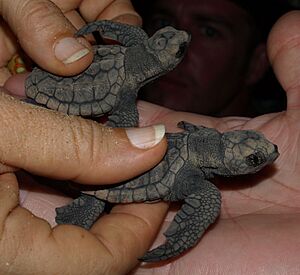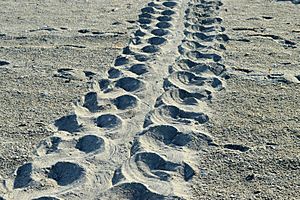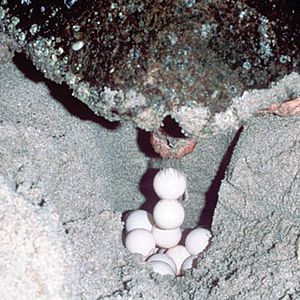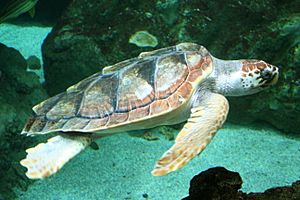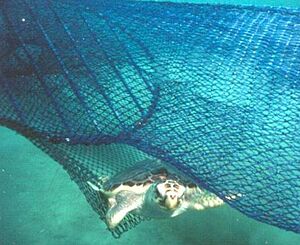Loggerhead sea turtle facts for kids
Quick facts for kids Loggerhead sea turtle |
|
|---|---|
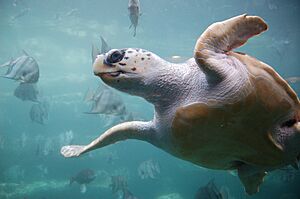 |
|
| Conservation status | |
| Scientific classification | |
| Genus: |
Caretta
|
| Species: |
caretta
|
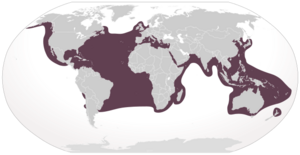 |
|
| Loggerhead sea turtle range according to the Food and Agriculture Organization
Species synonymy
Testudo caretta
Linnaeus, 1758 Testudo cephalo Schneider, 1783 Testudo nasicornis Lacépède, 1788 Testudo caouana Lacépède, 1788 Chelone caretta — Brongniart, 1805 Chelonia caouanna Schweigger, 1812 Caretta nasuta Rafinesque, 1814 Chelonia cavanna Oken, 1816 Caretta atra Merrem, 1820 Caretta cephalo — Merrem, 1820 Caretta nasicornis — Merrem, 1820 Chelonia caretta — Bory de Saint-Vincent, 1828 Testudo corianna Gray, 1831 Chelonia pelasgorum Valenciennes in Bory de Saint-Vincent, 1833 Chelonia cephalo — Gray, 1829 Chelonia (Caretta) cephalo — Lesson in Bélanger, 1834 Chelonia caouanna — A.M.C. Duméril & Bibron, 1835 Chelonia (Thalassochelys) caouana — Fitzinger, 1836 Chelonia (Thalassochelys) atra — Fitzinger, 1836 Thalassochelys caretta — Bonaparte, 1838 Chelonia (Caouanna) cephalo — Cocteau in Cocteau & Bibron in de la Sagra, 1838 Halichelys atra — Fitzinger, 1843 Caounana caretta — Gray, 1844 Caouana elongata Gray, 1844 Thalassochelys caouana — Agassiz, 1857 Thalassochelys corticata Girard, 1858 Chelonia corticata — Strauch, 1862 Thalassochelys elongata Strauch, 1862 Thalassochelys caouana Nardo, 1864 Eremonia elongata — Gray, 1873 Caretta caretta — Stejneger, 1873 Thalassochelys cephalo — Barbour & Cole, 1906 Caretta caretta caretta — Mertens & L. Müller, 1928 Caretta gigas Deraniyagala, 1933 Caretta caretta gigas — Deraniyagala, 1939 Caretta caretta tarapacana Caldwell, 1962 Chelonia cahuano — Tamayo, 1962 Caretta careta [sic] Tamayo, 1962 (ex errore) Genus synonymy
Caretta
Rafinesque, 1814 Caretta (Thalassochelys) Fitzinger, 1835 Thalassochelys Bonaparte, 1838 Caouana Cocteau in de la Sagra, 1838 Halichelys Fitzinger, 1843 Eremonia Gray, 1873 ?Pliochelys Portis, 1890 ?Proganosaurus Portis, 1890 |
|
The loggerhead sea turtle (Caretta caretta) is a species of oceanic turtle distributed throughout the world. It is a marine reptile, belonging to the family Cheloniidae.
Contents
Description
Loggerheads are named for their large heads and powerful jaws, adapted for crushing hard-shelled prey like whelks, conchs, and crabs. The skin ranges from yellow to brown in color, and the shell is typically reddish brown. No external differences in sex are seen until the turtle becomes an adult, the most obvious difference being the adult males have thicker tails and shorter plastrons (lower shells) than the females.
Size and weight
The average loggerhead measures around 90 cm (35 in) in carapace length when fully grown. The adult loggerhead sea turtle weighs approximately 135 kg (298 lb), with the largest specimens weighing in at more than 450 kg (1,000 lb).
Habitat and distribution
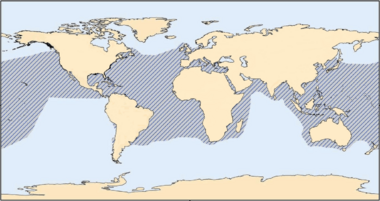
The loggerhead sea turtle is found in the Atlantic, Pacific, and Indian Oceans, as well as the Mediterranean Sea. They spend most of their lives in the open ocean and in shallow coastal waters. They rarely come ashore besides the females' brief visits to construct nests and deposit eggs. Major U.S. nesting occurs in Florida, South Carolina, and the Gulf of Mexico, while Oman hosts the second-largest nesting population worldwide .
Behavior
Loggerhead sea turtles observed in captivity and in the wild are most active during the day. In captivity, the loggerheads' daily activities are divided between swimming and resting on the bottom. While resting, they spread their forelimbs to about midstroke swimming position. They remain motionless with eyes open or half-shut and are easily alerted during this state. At night, captives sleep in the same position with their eyes tightly shut, and are slow to react. Loggerheads spend up to 85% of their day submerged, with males being the more active divers than females. The average duration of dives is 15–30 min, but they can stay submerged for up to four hours.
Diet
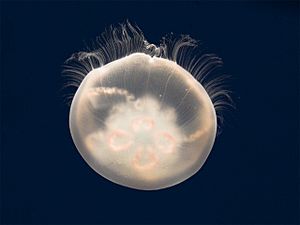
Loggerhead sea turtles are omnivorous, feeding mainly on bottom-dwelling invertebrates, such as gastropods, bivalves, decapods, and horseshoe crabs. It has a greater list of known prey than any other sea turtle. Other food items include sponges, corals, sea pens, polychaete worms, tube worms, sea anemones, cephalopods, barnacles, brachiopods, amphipods, isopods, Portuguese men o' war, insects, bryozoans, hydrozoans, sea urchins, sand dollars, sea cucumbers, starfish, tunicates, fish (eggs, juveniles, and adults), hatchling turtles (including members of its own species), algae, and vascular plants. During migration through the open sea, loggerheads eat jellyfish, floating molluscs, floating egg clusters, squid, and flying fish.
Reproduction
Females nest every 2–4 years. The eggs are typically laid on the beach in an area above the high-tide line. The eggs are laid near the water so the hatchlings can return to the sea.
All sea turtles have similar basic nesting behaviors. They exit the water, climb the beach, and scrape away the surface sand to form a body pit. With their hind limbs, they excavate an egg chamber in which the eggs are deposited. The females then cover the egg chamber and body pit with sand, and finally return to the sea. This process takes one to two hours. Loggerheads have an average clutch size of 112.4 eggs.
Nest temperature determines hatchling sex. Eggs kept at a constant incubating temperature of 32 °C become females. Eggs incubating at 28 °C become males.
Hatchlings range in color from light brown to almost black, lacking the adult's distinct yellows and reds. Upon hatching, they measure about 4.6 cm (1.8 in) and weigh about 20 g (0.7 oz).
After incubating for around 80 days, hatchlings dig through the sand to the surface, usually at night. Hatchlings enter the ocean by navigating toward the brighter horizon created by the reflection of the moon and starlight off the water's surface.
Migration
These turtles are known for transoceanic journeys. For example, Pacific loggerheads hatch in Japan and migrate to feeding grounds near Baja California, traveling up to 8,000 miles .
Predators

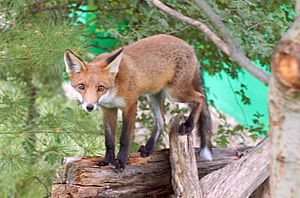
Loggerheads have numerous predators, especially early in their lives. Egg and nestling predators include ghost crabs, oligochaete worms, some beetles, flesh fly larvae, some ants, flesh flies, snakes, gulls, corvids, opossums, bears, rats, armadillos, mustelids, skunks, canids like coyotes, dingos, the Red foxes in Australia, Jackals and feral dogs, procyonids, Feral cats, Feral pigs, and humans. During their migration from their nests to the sea, hatchlings are preyed on by dipteran larvae, crabs, toads, lizards, snakes, seabirds such as frigatebirds, and other assorted birds and mammals. In the ocean, predators of the loggerhead juveniles include portunid crabs and various fishes, such as parrotfishes and moray eels. Adults are more rarely attacked due to their large size, but may be preyed on by large sharks, seals, and killer whales. Nesting females are attacked by flesh flies, feral dogs, and humans. Salt marsh mosquitos can also pester nesting females.
In Australia, the introduction of the red fox (Vulpes vulpes) by British settlers in the 19th century led to significant reductions in loggerhead sea turtle populations.
Along the southeastern coast of the United States, the raccoon (Procyon lotor) is the most destructive predator of nesting sites.
Up to 40% of nesting females around the world have wounds believed to come from shark attacks.
Lifespan
The loggerhead reaches sexual maturity within 17–33 years and has a lifespan of 47–67 years.
Threats
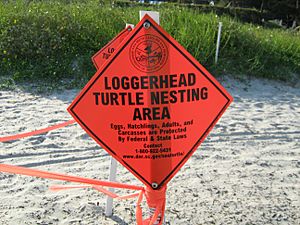
Loggerhead sea turtles were once intensively hunted for their meat and eggs.
Fishing gear is the biggest threat to loggerheads in the open ocean. They often become entangled in longlines or gillnets. They also become stuck in traps, pots, trawls, and dredges. Caught in this unattended equipment, loggerheads risk serious injury or drowning. Turtle excluder devices for nets and other traps reduce the number being accidentally caught.
Nearly 11 million metric tons of plastic are released into the ocean annually. A number that is projected to increase to 29 million metric tons by 2040. Turtles ingest a wide array of this floating debris, including bags, sheets, pellets, balloons and abandoned fishing line. Loggerheads may mistake the floating plastic for jellyfish, a common food item. The ingested plastic causes numerous health concerns, including intestinal blockage, reduced nutrient absorption and malnutrition, suffocation, ulcerations, or starvation. Ingested plastics release toxic compounds, including polychlorinated biphenyls, which may accumulate in internal tissues. Such toxins may lead to a thinning of eggshells, tissue damage, or deviation from natural behaviors.
Artificial lighting discourages nesting and interferes with the hatchlings' ability to navigate to the water's edge. Artificial lighting causes tens of thousands of hatchling deaths per year.
Destruction and encroachment of habitat by humans is another threat to loggerhead sea turtles.
Annual variations in climatic temperatures can affect sex ratios, since loggerheads have temperature-dependent sex determination. High sand temperatures may skew gender ratios in favor of females. This raises concern over the connection between rapid global temperature changes and the possibility of population extinction.
Tropical Cyclones have a significant impact on hatchling loss. The associated storm surges push water higher up the beach, flooding nest and drowning the embryos. Strong wave action may eroded away sand, exposing the eggs to drying and predation. The current trend of rising sea surface temperatures and the increase in both numbers and intensities of tropical cyclones as a result of climate change pose a growing threat to turtle populations.
Conservation status
Loggerhead sea turtles are listed as Vulnerable by IUCN, with 9 distinct populations classified as either Threatened or Endangered under the U.S. Endangered Species Act.
Conservation efforts
Since the loggerhead occupies such a broad range, successful conservation requires efforts from multiple countries.
Many people and organizations around the world are working hard to protect loggerhead sea turtles.
- Protecting nests: Volunteers and scientists patrol beaches during nesting season to find and protect nests, sometimes moving them to safer locations.
- Reducing bycatch: Using TEDs and changing fishing practices help reduce the number of turtles caught accidentally.
- Cleaning up the ocean: Efforts to reduce plastic pollution help protect turtles from eating trash.
- International cooperation: Since loggerheads travel so far, protecting them requires countries to work together. CITES bans trade, while the Inter-American Convention (IAC) coordinates habitat protection across the Americas.
Quick Facts
- Scientific Name: Caretta caretta (say it: "kah-RET-tah kah-RET-tah!"), introduced in 1873 by Leonhard Stejneger.
- Size: As long as a bike (up to 3.5 feet/1.1 m) and as heavy as a baby elephant (up to 1,200 lbs/545 kg).
- Speed: Swims up to 15 mph (24 km/h)—faster than you on a scooter!
- Lifespan: 50–80 years.
- Favorite foods: Crabs, jellyfish, and even sea urchins.
Interesting facts about the Loggerhead sea turtle
- Carl Linnaeus gave the loggerhead its first binomial name, Testudo caretta, in 1758.
- The English common name "loggerhead" refers to the animal's large head.
- Hatchlings can lose up to 20% of their body mass due to evaporation of water as they journey from nest to ocean.
- It might seem that they "cry" when really they’re just getting rid of extra salt!
- Their shells are like apartments —tiny crabs and algae live on them.
- They hold their breath for 7 hours while sleeping underwater.
- The loggerhead sea turtle appears on the $1000 Colombian peso coin.
- In the United States, the loggerhead sea turtle is the official state reptile of South Carolina and also the state saltwater reptile of Florida.
Related pages
See also
 In Spanish: Tortuga boba para niños
In Spanish: Tortuga boba para niños
- Adelita, the first sea turtle tracked across an ocean basin.
- İztuzu Beach, one of the prime nesting habitats of the loggerhead turtle in the Mediterranean
- Sea turtle threats



